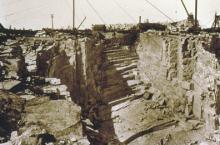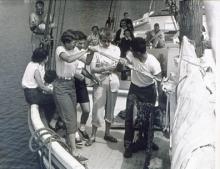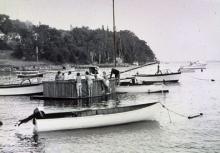Changes in Industries and the Rise of Tourism
Over time industries grow, then become outmoded or uneconomical due to competition or to new products. Natural resources become depleted. The industries of Penobscot Bay were no exception.
Structural steel lessened the demand for granite. Steel, efficient steam engines, and canals led to the demise of the wooden sailing ship. ConcreteConcrete
Cement mixed with an aggregate, such as sand or gravel, and used as a building material., cementCement
Mixture of clay, lime, and other materials ground to a powder and heated together so that the mixture combines (sintering)., and gypsumGypsum
A widely-distributed mineral consisting of hydrous calcium sulfate that is used especially as a soil amendment and in making plaster of paris and cement. wall board ended the limeLime
Calcium oxide (CaO), obtained from limestone, and used in mortars, plasters, cement, bleaching powder, and in making paper, glass, and steel. industry. The natural ice industry suffered when conglomeration of ice companies eliminated competition. It was completely destroyed by the invention of mechanical ice making. Other extractive industries such as lumber and fishing suffered from over-harvesting.
Competition played a major part in the decline of Penobscot Bay’s marine industries. Europe, especially Britain, dominated the world’s oceans in the early 20th century. Railroads carried many cargoes more cheaply than vessels, and had the advantage of access to more destinations. By the mid 20th century, roads, automobiles, and trucks took over much of the commerce previously handled by water and rail. More roads for car traffic resulted in the blossoming of a new industry: tourism.
Rusticators and Tourism
Early vacationers came to Maine by steamboat or railroad. Some early rusticatorsRusticators
Late nineteenth and early twentieth century name for vacationers to Maine, who came from big cities on the East Coast to experience a rustic life and healthful air. were artists who wanted to capture the beauty of Maine’s coast and mountains. Frederick ChurchChurch, Frederick Frederick Church
1826-1900. Artist of the Hudson River School of landscape painters. He traveled and painted extensively in Maine in 1854-1856.
Read More, who painted scenes from Maine in the 1840s and 50s, was a leader in this movement.
After the Civil War, academics and businessmen came to buy land and build summer “cottages.” The very wealthy built large houses. They came from Boston, Philadelphia, and New York as well as cities in the Midwest. Wealthy vacationers congregated in colonies that reflected their winter residences: New Yorkers in Mount Desert, Philadelphians in Camden, Bostonians in North Haven. By the 1880s, developers began building large hotels, including the original Samoset in Rockland, for the more modest upper middle class market.
Tourism has increased sharply in the last forty years, as interstate highways have made the trip to Maine easier. The Penobscot Bay windjammerWindjammer
Once a derisive term used by steamship sailors who looked scornfully at the old fashioned square-rigged sailing ships. Now a term used to describe any large sailing ship of any type. fleet began in 1936, the same year Penobscot Marine Museum was founded; both operations work to preserve our maritime heritage and share the excitement of the past through activities today. More and more, through ecotourismEcotourism
Tourism focused on travel for the purpose of observing or learning about wildlife or the environment., people are getting to know Penobscot Bay’s history and environment, while providing jobs and business opportunities to Mainers today.



